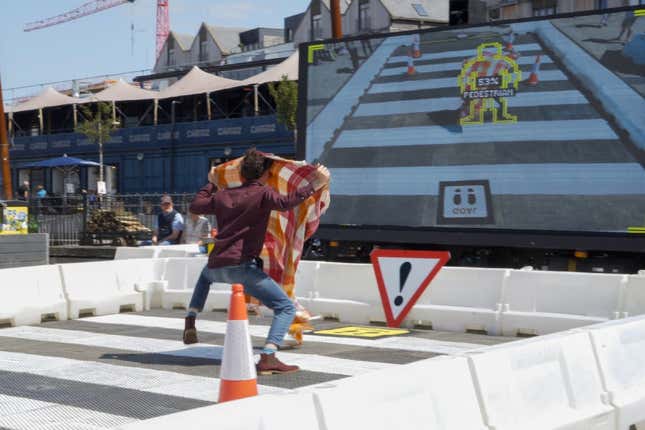This time, I know I’m onto a winning strategy. I’ve gathered three parking cones, and set about plopping one atop my head and the others on the ends of my arms, Mega Man buster cannon-style. I ask my friend nearby to punch the start button for me. Squishing my legs together as one, like I’m hopping on a tiny pogo stick, I bounce through the (fake) crosswalk, my silhouette on the large screen most closely resembling an 8-bit cactus.
This Action Game Asks What If Ninja Gaiden Let Its Hair Down
Within mere seconds, the sensor clocks me as a human, and I’m branded a loser for all in attendance of the indie-game showcase Day of the Devs to see. So much for my cunning plan.
In How (Not) To Get Hit By A Self-Driving Car, a “public game” developed by Tomo Kihara and Daniel Coppen, you’re tasked with convincing an AI that you’re not a pedestrian. That means you need to change the shape of your silhouette by crawling, scuttling, or covering distinguishing human features like two legs and a little round head. If you “win,” you’ve outwitted the AI and would be clever enough to be hit at full speed by an autonomous vehicle. Hooray?
This isn’t a stripped-down version of self-driving car technology like you might expect. How (Not) To Get Hit By A Self-Driving Car is built around what’s known as a Single Shot Detector (SSD), a common object detection algorithm trained on a large-scale dataset. In other words, this is some of the real-world tech being used to design the cars of the future.
If a player manages to complete a successful run of How (Not) To Get Hit By A Self-Driving Car, they’re presented with a choice: to use their footage to further train the AI, or to immediately delete their data. It’s a tricky conundrum—and one I never had to face, after several more unsuccessful attempts—do you want to protect your privacy, or improve an innovation? But you could also interpret the decision to “help” as furthering potentially harmful technology. There’s no clear correct answer, and I noticed several of the lucky few who managed to beat the AI ran out of time before they could choose either way, so their data was deleted by default.
Don’t get me wrong: watching people play this game in real life is hilarious, and that’s no small part of its appeal. It’s not every day you see folks lining up for the chance to roll around on the ground like a potato bug, trundle sideways on all fours while covered in a coat, or scurry like a crab while covering their arms with parking cones.
But it also makes the idea of suddenly unleashing this technology on the streets a pretty horrifying prospect. What about folks using wheelchairs, or pushing a shopping cart? What if a kid dashes into the street in a Halloween costume? Winning in How (Not) To Get Hit By A Self-Driving Car makes you realize just how rudimentary much of this technology still is.

The queasy-making ambiguity is kind of the point, according to the developers. In a press release from the game’s initial demo in July 2023 in Bristol, U.K., they write, “advanced image recognition systems are being increasingly deployed in the public space, often without the awareness of the citizens they affect. By inviting the public to play, the game aims to become a platform to understand how these systems work, fostering dialogue about the challenges and potential dangers they present.”
How (Not) To Get Hit By A Self-Driving Car doesn’t have a wide release planned anytime soon, presumably due to the scale of the technology it relies on. But I hope to see it at another indie event in the future. I haven’t been able to stop thinking about it since.
